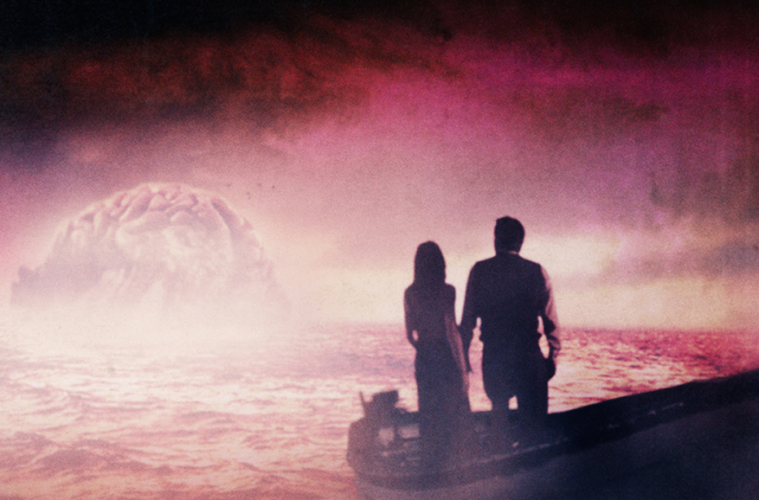
No film in recent memory leaps off the screen like The Forbidden Room, Guy Maddin and Evan Johnson‘s omnibus-like homage to numerous forms of cinematic storytelling. From the first splotchy, out-of-sync seconds, it’s clear that they’re attempting to play with the medium’s properties in a very direct, sometimes assaultive way, but this is no endurance test — in all its stories, threads, angles, and suggestions, it may also be the most consistently funny thing to hit theaters this year. (Imagine if Tim & Eric were aesthetic-obsessed cinephiles and you’ll start to get the idea.)
Because the film has no decisive start or end point — and their Internet companion piece, Seances, only further reinforces this quality — our conversation could have gone anywhere, perhaps at the concession of coherence. But, as you’ll see, they’re far too familiar with their work and far too certain of their intentions to lose sight of the project. Just as no one but Guy Maddin could have made The Forbidden Room, no one but he and Johnson would be able to talk through it with such eloquence.
Having seen the film a few days ago, with your Q & A, and having given it some days to sit… this still feels like a movie you could talk about for days on end. The endless, Möbius strip-like quality means I can’t exactly pin anything down.
Guy Maddin: No one has invoked the Möbius strip, but it’s a metaphor I invoke often.
Did you invoke it here?
GM: I didn’t, but I often invoke it to describe the nightmare that is my life. It’s a very stubby Möbius strip; it doesn’t really shake things up much. No, but I’m pleased, because I do like the suggestion, because the Internet companion piece to this desires to tap into an infinite — an endless — motherlode of narrative, and reconfigure them with the same elements. “A Möbius strip of Kuleshov experiments.”
That’ll sell it to the masses.
GM: Yeah, that’s right! [Laughs] That’s right. “A little bit of Möbius.” No, and then this film just purports to be, I guess, one seance with lost cinema.
Have you thought of the Internet as a distribution format for a long time? I feel like it’s well-suited for you, so you doing this, here, wasn’t surprising. It seemed like something you would keep in mind for a while.
GM: Yeah, it was, because I just knew, before I started working with Evan, that to get these Guy Maddin movies out into the world, it took a lot of grassroots work — the kind of work that the Internet can do in its sleep. It can find whoever might like this stuff very quickly. And so it struck me that maybe the Internet… instead of complaining about distributors sliding my movie on the shelf or not getting the poster design right — or something like that — just put it on the Internet already. There’s ways of manipulating that, to bring it to people better, but it just seemed like the place to try to work.
Then it turned out to be such a big project, and a couple of things made us want to make a companion piece to the Internet project that was a feature film. One, we were big fans of the feature film, wanted to make a feature film, and didn’t want to spend five years working on an Internet project and then think of a feature film. It also really helped finance the Internet project, to make a feature film, because you can access more money to make a feature film. They fed each other perfectly; the vast amount of narrative material we sourced for our Internet project fit into our feature. And then the feature kicked back some money, and they just sort of exist as companion pieces that I hope, some day, enrich each other. There’s a tendency for people to think of websites as just working in service of a movie, but that’s not the case here.
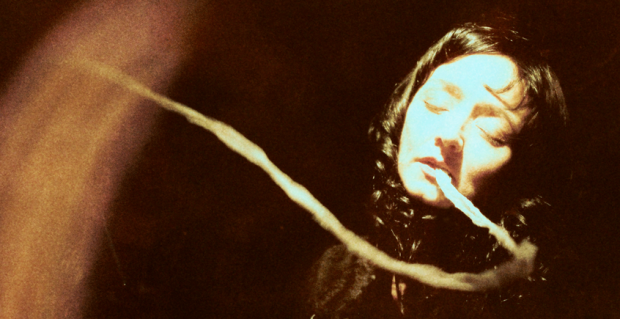
You guys must be proponents of the big-screen experience, though.
GM: Yeah.
I had a chance to see this on a DVD, but when I knew there would be a New York Film Festival screening, I thought I should see it theatrically. By the opening credits, I knew I’d made the right choice.
GM: I think so. I’m going to have to be thrilled people are watching it on whatever-sized screen in the long haul, but it’s the first movie I’ve been involved with where I really feel it’s really much better on the big screen.
Why this?
GM: A lot of it is the work Evan did in post. We captured HD, raw color footage, and then he and his brother, the production designer Galen, went to work, and I love the way it looks.
Have you fully embraced home video, though? I feel like this is a particularly interesting test case.
GM: Yeah.
Not that your work is necessarily imprecise, but this feels so precise in its cinematographic character that, to see it on Blu-ray… are you guys excited by the HD format?
Evan Johnson: I do. I live in Winnipeg and I don’t have many big-screen options.
GM: Me either.
EJ: I can watch, like, Mission: Impossible. I’m not going to be able to see Cemetery of Splendour on a big screen, and I find that really, really, really irritating, because small screens, I’m just easily distracted. If I’m watching a screen that’s this size [makes rectangle with hands] and there’s a whiteboard over there —
GM: Luckily, we have a projector.
EJ: I feel like you need the immersion, and that’s why I object to the home-viewing experience — more because my own brain works in a certain way. Not because I don’t think it works for a lot of people. So I do like Blu-ray. It’s just slightly more immersive.
GM: I do, too. The earlier movies I made were all inspired by my earliest viewing obsessions, which were all VHS experiences. So I was happy with very little detail; I couldn’t afford detail in the screen, anyway. Usually I just used lack of light to suggest in the shadows of the film’s world, and so there was really nothing to miss by watching it on a small screen. But this is a big-screen movie, so a Blu-ray on a nice-sized television, luckily a lot of cineastes have that or will have that in the near-future, so we’ll probably be okay. I think it needs a good, high-resolution, nice sound — nice, loud volume. It drives me nuts when the volume’s turned down. It’s turned up to ear-bleeding levels for every movie except ours half the time, so, with this one, we always put in a special request for the volume to be up.
EJ: I watched Rosemary’s Baby on a plane yesterday, and it didn’t matter. It even says at the beginning, “Formatted to fit your screen,” and then they cropped it to not fit the screen, which is a widescreen on the plane. The sun was glaring on the screen during the movie, and it didn’t matter. Wouldn’t it be nice to make a movie where it didn’t matter? [Laughs]
GM: Yeah, exactly. You’re probably just boning yourself by making a movie where it matters. You’re better off making something where it doesn’t matter.
EJ: With Rosemary’s Baby, it doesn’t.
GM: Yeah, and His Girl Friday, or something. You can be amazed by it on any format.
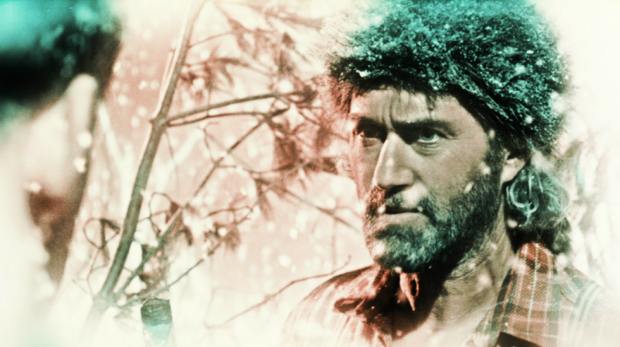
So do I. Watching it, I thought, “This must have taken a long time to get to its final state,” because it just appears in a way where you can see every inch of post-production work that was done. One thing I took note of in your Q & A was you saying you aren’t using digital technology, but “abusing” it.
GM: That’s the only way I can understand it, because that’s basically how Evan explained it to me. But maybe you want to…
EJ: Well, yeah. As you know all too well, when we were shooting the films, you saw the first rushes — these HD, digital video — you were horrified and really depressed at how ugly you thought it looked. I thought I could make it… [Laughs] I’d heard of post-production, that you could change color and do things in post-production, but I didn’t really know much about what it was, and I promised… I had a copy of Adobe Premiere and After Effects, and I thought, “I can learn to use it.” So I promised, “Oh, it’ll look great! Don’t worry.” I had to make good on that promise, but I did it sort of amateurly, so I was learning the programs as I went.
GM: I guess you learned those things the way I learned analog filmmaking: you just set off…
EJ: Right, which is why, in your analog films, there are mistakes that delighted you that you kept. As we were learning — because I didn’t know how to do things — I made mistakes, and often mistakes were producing very fruitful results. But it took a long time. Like, it was years in the post-production, I wasn’t working on it solidly the whole time, but as I was… I think it was probably that that effect comes from, like, if I’d taken a professional course, or something, then I would have never learned the mistakes. But how do you make mistakes properly?
GM: That’s a really important thing, when your modus operandi is to keep working quickly and to encourage accidents and encourage inspiration and panic.
EJ: So then the expertise I had to develop was just knowing what kind of mistakes were working, conceptually or visually, and which weren’t. But now I’m very adept at these things, technically, but at first I wasn’t, and so I think it was the learning that made it work. But that is how… I don’t know what I’ve learned about filmmaking from being on set with you. I’d never been on other film sets except yours, and then when I went on a real, professional film set, I was like, “Oh, this is weird. This is boring.” It wasn’t just chaos and madness, although it was that sometimes; all films are. Things made too much sense. There was too much order.
GM: There was someone to do every job.
EJ: So, anyway, post-production was, in short, all about reproducing disorder that you’d think digital technology was there to eliminate in the first place.
Do either of you know how long an average image — with all its splotches, blemishes, scratches — took, from raw footage to final form, to complete?
EJ: Of one frame, or…?
Let’s say there’s, say, a four-second shot. Can you just think of any shot and how long it might have taken? This might be a broad question.
EJ: Yeah, no, I get the question. I don’t know… a long time? A long time because we didn’t edit the movie first.
GM: You color-timed all the rushes!
EJ: Which meant toiling over… that four-second shot, would have actually been from, probably, a 45-second-long clip.
GM: The idea of color-timing all the rushes… even when I forgot to turn the camera off and went to the bathroom and stuff. That would give the editor those odd, gloopy, loopy moments to cut on, but rather than doing that after he’d done his cut.
EJ: We color-timed the slates. We’d make sure the slates look right.
GM: Can you imagine Disney animators back in 1939 or whatever carefully drawing the slates for Pinocchio? And the outtakes where Gepetto blows a line? Or he’s drinking a coffee and smoking a bud or something like that? It reminds me of that, somehow.
EJ: We felt a little guilty about digital technology, and have restored belief in it, somehow, by making it more difficult than it’s designed to be.
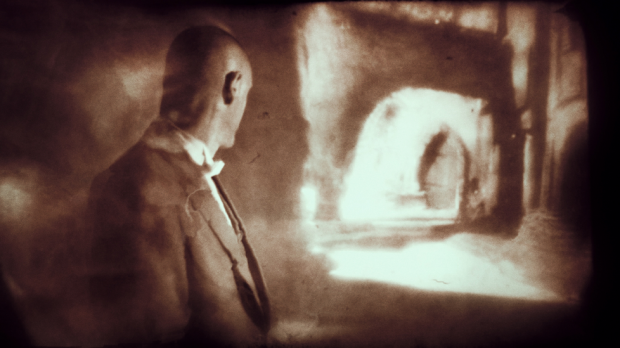
Since having premiered earlier this year, it’s been cut down a bit — from 130 minutes to 120. What motivated the excision?
GM: I’ve got nothing mischievous to say here. I don’t think it was finished when we showed it at Sundance. We had a chance to sit on it for a while. I’d watched it a couple more times. The Sundance premiere was marred for us by a faulty DCP, where the soundtrack’s left and right channels were as much as 15 seconds out of sync. We felt it really hadn’t had its premiere yet, but just watching it — and watching to make sure the DCP had, in fact, been repaired — it just felt like it needed the screws tightened a bit, so we just… now it’s finished. That’s all. There’s no alternate version; there’s no need to ever release it. Nothing was lost, actually; no stories were omitted. It was just some shots were shortened, a few were eliminated, a few intertitles were cut out. It’s just tightened.
Because you’ve been making films for so long and shown in so many places, have you had a lot of experiences like the Sundance thing?
GM: Oh, it’s always something. It’s best to make friends with the projectionist beforehand. It used to be, in the analog days, I made these films that were ferociously, willfully square aspect ratios, and so the first thing that would happen was the projectionist would just cut the top and the bottom off and project it in 1.85. The volume is never turned up enough, because I also stupidly decided they should be mono mixes, so that hurts the volume level right away. And then I’ve had some experiences.
Once, at Telluride, I was given a retrospective screening of my movie Careful, and my sweet distributors at Zeitgeist had assembled an “all-star print” of the best reel one, the best reel two, the best reel three of all the prints they had for this, but there was an accident when shuffling them together, so that there were two reel threes and no reel four. My walkout rates had really come down for Careful, my third feature, but I went back for the Q & A and the theater was virtually empty, and the only people that were still there were telling me how much they loved my strategy of repeating a huge stretch of the movie in the middle. There’s always something, but the DCP era seems to have opened up a whole new can of surprises that can torture a filmmaker. I’ve talked to projectionists now. I work at Harvard; I’ve made friends with the Harvard Film Archives projectionists. They sound like they’ve been in the DCP Wars now for 20 years, the horror stories that come out.
It’s funny, though, because — and I feel like you may have already answered this, but I should still pose it — the film has this sort of mysterious internal logic that, if you’re accepting of, you surrender to. Is it hard to find the specific moments to cut, or was it clear that one shot is too long, one segment could be pared down, etc.? Was it a moment-by-moment search?
EJ: We did that.
GM: Yeah, we watched it a few more times with that specifically and made notes about where it could go. We tried to be ruthless. With a conventional movie, you just try to decide where the pacing is boring; you yourself can tell when you’re bored as the filmmaker, and you just try to make the movie as tight as possible while still honoring its logical pacing. This was similar, but with one major difference: we really didn’t want… we could have shortened the movie to 75 minutes if we wanted to, but we still really wanted people to feel thoroughly exhausted by the experience. You wanted people to feel washed up on the shore, panting, after having barely survived a narrative storm at sea, and so we had to decide exactly how much was too much in the right way.
So that was tricky, and it’s a bit counter-intuitive, intentionally, leaving a bit too much in, and knowing how much is too much in the right way. It was tricky, but it was just a matter of going through… it was really amazing where, if you shortened one scene, it would destroy the scene after it, sometimes. So we found ourselves counter-intuitively putting back in footage that didn’t seem to earn its right to be there, because, by taking it out, it actually made the next scene arrive a little too quickly, and therefore go by without anyone paying attention, somehow. I learned a lot of things that I can’t even use ever again, because I think they just belong solely to this movie, the things I learned.
Is this a compromise, or do you learn to live with the fatty material?
GM: Oh, often it was just two seconds, anyway.
The kind of thing you two are most likely to notice.
EJ: Oh, yeah. No one else would notice.
GM: But, sometimes, because we would give notes to our editor, who would then follow them, but then there would be something like, “John, something doesn’t seem as good anymore. Did you shorten the scene beforehand?” He’d say, “Yeah, I thought it was a bit…” [Laughs] “Oh, okay!”
EJ: He’d try to get away with literally cutting one-half a second from a scene an hour and 48 minutes into the movie, and you couldn’t get it by us; we would notice. We didn’t know exactly what was lost, but we knew something felt wrong with the rhythm.
GM: We got him to fess up.
EJ: Well, we told him to sneak the movie down by a few minutes.
GM: Yeah, absolutely. At one point, we just ran it through the computer once at 110% the speed, just so everything was sped up.
EJ: It shortened the movie by eleven minutes.
GM: That was it. But then I became worried, and rightfully so, that some intertitles would race by too quickly. It turns out that some of the scenes were cut very beautifully, with this very specific rhythm, and you can’t just speed those up by 10% without destroy them entirely somehow. We had to do it the hard way: by watching the movie again and deciding what we wanted to take out.
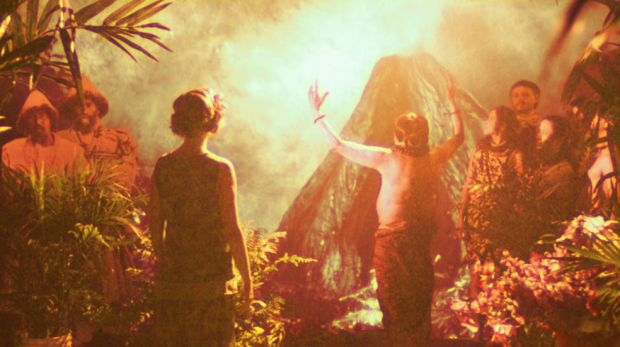
How many times have you seen this movie by now?
GM: Well, counting the earlier cut, where we thought we were finished, maybe still only ten times, or something like that.
EJ: Yeah, I was going to say twelve or thirteen.
GM: Something like that. But I don’t need to see it anymore. The most recent viewing I had was very pleasant, because there’s a French version of the movie with French intertitles and English dialogue, still, but subtitled into French. Some of the French actors couldn’t speak English, and so they memorized their dialogue by phonetically writing out the English and reciting it out. One of them is Jacques Nolot, who I watched the movie with in Paris. So he was watching, I guess, and reading the French subtitles, the lines that he had read phonetically, and so he’s finally understanding what it was he said.
It almost seems appropriate for this movie.
EJ: That’s probably the simplest way to do this.
GM: [Laughs]
One thing I have to ask, since this has been on my mind since seeing it, is the consistency of the performances, in that they all feel like they’re of this world. I mean, Maria de Medeiros looks like she walked out of a 1923 European silent film. It’s amazing.
GM: I think she plopped out of the womb looking like that. [Both laugh]
I’d really like to know if, when working with the actors, you had to explain a lot, if they asked a lot of questions, or if they were just willing to go with it.
GM: They seemed to just default to these performances. Evan has theorized that maybe it’s the atmosphere of the set, where I encourage a kind of disinhibition that comes out and comes out more as a spilling-out of the id as well as silent-movie shorthand. Also, the dialogue — when there is dialogue — is written in a mannered sort of storybook lingo that seems to force hands into miming reinforcements. But also maybe the spirit of the whole thing was kind of crazy, so it just encouraged disinhibition. So I found myself giving just the same two directions over and over again, which was “again” and “smaller.” I didn’t have to encourage them to be bigger, and I didn’t take them down much either. I was kind of pleased. It’s almost like the script forced them to do that, I think.
Actors are kind of amazing. Good actors are amazing: they read a script and they bring something to it. I’ve rarely encountered someone who is fighting your script. Of course, they’re not likely to have said “yes” to be in the movie, anyhow. I’ve only once had something like that, where someone fought me for a whole project — on Twilight of the Ice Nymphs, way back in the mid-‘90s. Someone who just fought me on the style of acting, and I wasn’t strong enough, or I didn’t know what to do with other styles, so it just ended up being a disaster. Everyone else since then has been up for it, whether I just hauled them off the sidewalks of Winnipeg or found them through Paris’ most intuitively brilliant casting director. They’ve delivered something I’ve been happy with.
For instance, I just can’t stop thinking about Mathieu Amalric’s death glare towards Udo Kier.
GM: Oh, yeah.
EJ: That’s acting!
That whole scene is just incredible. Is this the kind of thing where, when you write the performance, are you noting mannerisms and characteristics with great detail?
GM: I don’t think we wrote the description, but I remember we acted that script out.
EJ: We knew exactly who we needed, and although we didn’t know it would be Mathieu Amalric, that was a case where it turns out he was literally our dream. Like, of all the actors in the world, he was the one I wanted. We knew he was from Paris and we were shooting in Paris; that was all we knew. And so that was a dream come true, I guess. And we knew, physically, how it should look — the tone, everything. Of course Mathieu Amalric just slipped right in there and did it exactly right.
GM: Yeah, and I didn’t have to ask him to do anything.
EJ: He knew what it was about. A cowardly, dishonest man — he knew how to do that.
GM: I think he even was in character that day. He’d shown up on set that day… somehow he’d had to look after his toddler son or something because he’d done something wrong the night before at home, or something. [Both laugh] And he was kind of looking after his son. He said, “I knew I agreed to be in this movie, but I have a toddler! But he will not be any trouble!” He had already hit the ground running, showing up on set or something.
EJ: He was making excuses and denying things. [Both laugh]

The Forbidden Room played at this year’s New York Film Festival and will begin a theatrical release on Wednesday, October 7.

